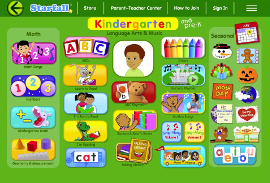Starfall Education Foundation is a nonprofit organization that offers both free and paid resources on their website. Starfall® began with resources for learning to read, and they have expanded to offer math and language arts resources for pre-kindergarten through fifth grade. The site is ideal for children at the beginning reading stage and that is the aspect of the site I focus on in this review.
Many of their resources are free, but membership gives you access to additional reading activities (particularly past the early stages), their math lessons and activities, and many more animated songs. Apps for mobile devices are available for both the free and the membership content.
Free Resources
Most of the free material is for teaching reading with phonics, and the beginning reading activities are outstanding. Their webpage, “Learn to Read with Phonics, Fluency, and Comprehension,” explains how to use their resources, including the animated, online lessons; printable pages; and readers. Everything is very high quality, from the animated lessons to the attractively designed, printable pages.
The animated online lessons are easy for children to do on their own. The first set of lessons briefly introduces the letters of the alphabet and their sounds.
The “Learn to Read” section that comes next covers the basics of a beginning reading program. The 15 lessons in this section have two main components: a game and an instructional lesson. The game has students move letters to make words, working on a common phonetic pattern. The instructional lessons each begin by teaching a new phonetic element, usually presented through a musical rhyme and animation. This is followed by an animated reader. Children can read on their own if they are able, or they can listen to an excellent audio reading of the story. The lessons help children learn both short- and long-vowel words and the r-controlled vowels (e.g., er, ar, or). A third component that is included with most lessons adds work on a reading or phonics skill, such as the consonant digraph sh.
At the bottom of the “Learn to Read” index page is a link to books and printable pages that are an essential part of the program. There are two books: the 98-page Level I Reading and Writing Journal: Block Print and the 96-page Level II Reading and Writing Journal.
The first page of the Level I Reading and Writing Journal: Block Print shows the forms for all of the letters, but it is not intended to be your first resource for teaching children how to write their letters. Children will complete activities such as tracing (reinforcing their knowledge of how to write the letters), filling in a missing letter, writing words in letter boxes, circling the correct word to complete a sentence, identifying pictures of words with particular vowel sounds, identifying rhyming words, writing complete words with common phonetic elements, tracing and writing complete sentences, writing words in alphabetical order, using punctuation marks, writing contractions, identifying antonyms, writing compound words, and writing number words. These are activities that typically stretch across kindergarten and first grade.
The Level II Reading and Writing Journal begins with activity pages that are more challenging than those in the first book, then it shifts the emphasis entirely to composition. It provides story starters and word banks along with space for children to draw a picture and write their own story. There are four pages for each of 22 story-writing activities. The amount of writing in this journal makes it quite a leap from the Level I Journal. Use your own judgment as to the best time to use it.
The printables also include three award certificates and a set of 15 black-and-white readers with the same content as the stories in the animated lessons but without color or animation. You also have the option to purchase the 15 readers as full-color, printed books and the Reading and Writing Journals printed in black and white. The Level I Reading and Writing Journal is also available with a slant-print style of handwriting, but only as a printed book.
The next section on the website, “It’s Fun to Read,” has a collection of activities headed Magic, Art Gallery, Music, Poetry, All About Me!, Tongue Twisters, and Bird Riddles. These activities sometimes teach about a phonetic element at the end, even though the topic isn't about phonics. Children can read and do some of these activities on their own.
The “I’m Reading” section on the website has subheadings labeled Three Little Plays, Fiction and Nonfiction, Folk Tales, Greek Myths, and Chinese Fables. Within each section are a number of colorful readers. These readers use a limited vocabulary with mostly words that children should be able to sound out at this stage. The readers include the option of having the program read the stories aloud.
The “c-a-t Word Machine” section helps students learn how to blend the sounds of letters to make words. Even though the icon for this section makes it appear to come much later in the sequence, you might want to use it along with the lessons in the “Learn to Read” section.
There are a number of other sections with free material that includes additional readers, nursery rhymes, motion songs, and a collection of songs.
Summary
The reading material on Starfall is extensive, but probably not quite enough for most children to learn all of phonics. You can use Starfall’s resources alongside another phonics program. For instance, you might want to consider using Plain and Not So Plain’s free kindergarten/first-grade program which incorporates many of the Starfall resources within a comprehensive program.
Starfall is really an amazing resource that should be helpful to many homeschooling parents with young children.








